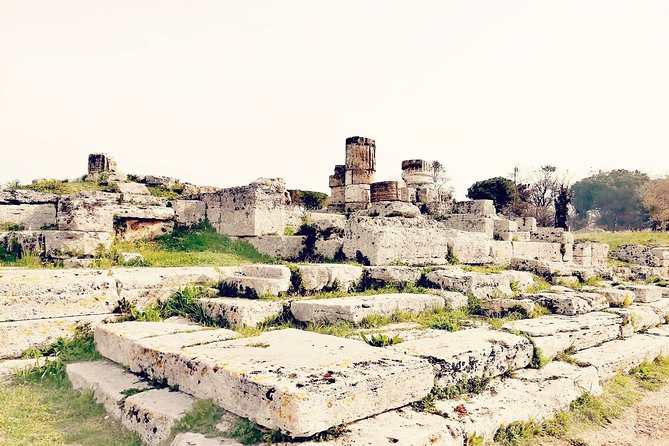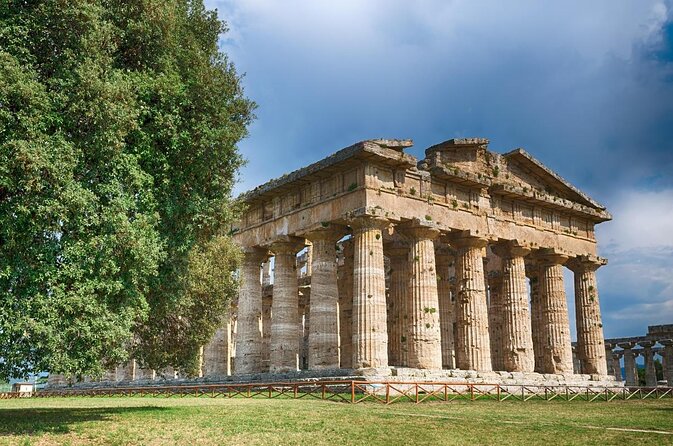Nestled amidst the rolling hills of Campania like a time capsule waiting to be opened, Paestum’s UNESCO World Heritage status is a beacon for history enthusiasts and architectural aficionados alike.
The ancient city’s allure goes beyond its well-preserved Greek temples; it beckons visitors to uncover the mysteries hidden within its ancient ruins. As one steps into this archaeological wonderland, a journey through time begins, promising to unravel tales of civilizations long gone.
But what secrets lie within the walls of Paestum, and what stories do its stones whisper to those who walk among them?
Good To Know

- Paestum’s ancient temples showcase meticulous craftsmanship and cultural significance.
- The site provides insights into religious beliefs and daily life of past inhabitants.
- Ongoing conservation efforts ensure the long-term protection and integrity of the archaeological remains.
- Interactive tours and educational exhibits offer a rich visitor experience at Paestum.
History of Paestum

The ancient city of Paestum boasts a rich and storied history, offering a glimpse into the captivating past of this UNESCO World Heritage site. Through archaeological discoveries, visitors can enjoy the remnants of ancient ruins that date back to the Greek colonization of the area around the 6th century BC.
These well-preserved ruins serve as a testament to the city’s former glory, showcasing magnificent temples dedicated to Hera, Athena, and other deities. The archaeological findings in Paestum provide valuable insights into the daily life, religious practices, and architectural achievements of the ancient inhabitants.
Exploring these ancient ruins allows visitors to appreciate the craftsmanship and cultural significance of this historical site.
Interested in history? More Campania historical sites we've covered
Architectural Marvels

Among the ancient architectural marvels of Paestum, stand three majestic temples dedicated to revered deities, showcasing intricate designs and historical significance.
These temples, namely the Temple of Hera, the Temple of Athena, and the Temple of Neptune, exhibit remarkable architectural innovations and construction techniques of the ancient Greek civilization. The Doric style columns, sturdy stone blocks, and precise geometric proportions used in their construction highlight the expertise of the builders.
The temples’ well-preserved condition allows visitors to appreciate the meticulous craftsmanship and attention to detail that went into their creation. Each temple’s layout and design reflect the religious beliefs and cultural practices of the time, providing valuable insights into the architectural prowess and spiritual devotion of the ancient inhabitants of Paestum.
Cultural Significance
Exuding a profound sense of heritage and tradition, Paestum’s cultural significance resonates through its ancient structures and artifacts. The site encapsulates centuries of cultural traditions and artistic masterpieces, offering visitors a glimpse into the past.
- Rich History: Each monument at Paestum tells a story of the ancient civilization that thrived in the region.
- Artistic Detail: The intricate carvings and architectural designs showcase the artistic prowess of the past inhabitants.
- Ceremonial Practices: The temples and structures provide insights into the religious and ceremonial practices of the time.
- Influence on Modern Culture: Paestum’s influence can be seen in various aspects of modern culture, from art to architecture.
- Symbol of Resilience: The preservation of Paestum stands as a testament to the resilience of cultural heritage in the face of time.
Preservation Efforts
Paestum’s commitment to preserving its cultural heritage is evident through ongoing conservation initiatives. Conservation efforts at the site focus on maintaining the integrity of the ancient Greek temples and ensuring the long-term protection of the archaeological remains.
Heritage protection plays a crucial role in safeguarding the historical significance of Paestum for future generations. Conservation initiatives include regular monitoring of the site’s structural stability, restoration work to combat erosion, and the implementation of measures to prevent environmental damage.
These efforts aim to preserve the authenticity and beauty of Paestum’s architectural wonders, allowing visitors to experience the site’s rich history in its most genuine form. Through dedicated heritage protection strategies, Paestum continues to uphold its status as a UNESCO World Heritage site.
Visitor Experience
Visitors to the UNESCO World Heritage site of Paestum can expect an immersive journey into the ancient world through captivating archaeological wonders and well-preserved historical artifacts.
Interactive Tours: Engaging guided tours offer in-depth exploration and understanding.
Sustainable Tourism Practices: Emphasizing eco-friendly initiatives for preserving the site’s integrity.
Educational Exhibits: Informative displays enhance visitors’ knowledge of Paestum’s rich history.
Visitor Centers: Well-equipped facilities provide information and assistance for a seamless experience.
Multilingual Guides: Knowledgeable guides offer insights in various languages, catering to diverse visitors.
Local Cuisine Delights
Enjoy a culinary adventure as you discover the delectable local cuisine delights awaiting visitors at the UNESCO World Heritage site of Paestum. The region boasts a rich culinary heritage, offering a variety of delicious specialties rooted in traditional culinary traditions. Here is a glimpse of what you can savor:
| Culinary Delight | Description | Recommended Pairing |
|---|---|---|
| Mozzarella di Bufala | Creamy buffalo mozzarella | Fresh tomatoes and basil |
| Aglianico Wine | Robust red wine made from Aglianico grapes | Local cheeses and meats |
| Delizie al Limone | Lemon-flavored pastries | Espresso or limoncello |
Indulge in these delectable treats to truly experience the flavors that define Paestum’s culinary identity.
Tips for Travelers
Wondering how to make the most of your visit to Paestum? Here are some traveler insights to help you uncover hidden gems:
Early Bird Gets the Worm: Arrive early to avoid crowds and capture stunning photos of the ancient ruins in the soft morning light.
Local Eats: Don’t miss trying buffalo mozzarella from a nearby farm; it’s a local specialty that will tantalize your taste buds.
Guided Tours: Consider joining a guided tour to learn more about the history and significance of Paestum from knowledgeable experts.
Sun Protection: Remember to pack sunscreen, a hat, and plenty of water, as the Mediterranean sun can be intense during your exploration.
Off the Beaten Path: Take time to wander off the main paths to discover quiet corners and lesser-known archaeological treasures.
Common Questions
Can Visitors Bring Their Own Food and Drinks to Enjoy at the Paestum UNESCO World Heritage Site?
Visitors can bring their own food and drinks to enjoy at the site. Food options vary, with designated picnic spots available for a relaxed dining experience amidst the heritage. It’s a great way to savor a meal while exploring.
Are There Any Restrictions on Photography or Filming at Paestum?
Photography restrictions and filming restrictions may apply at certain locations to protect privacy, preserve the environment, or respect cultural norms. Visitors should inquire about any guidelines in place before capturing images or videos.
Is There a Specific Dress Code That Visitors Need to Follow While Exploring the Site?
When exploring the site, visitors should adhere to a dress code that respects cultural norms. This may include covering shoulders and knees. By following these guidelines, visitors can show respect for the cultural heritage of the location.
Are There Guided Tours Available at Paestum, and How Can Visitors Book Them?
Visitors can explore Paestum through guided tours which offer enriching experiences. Booking options are available online or on-site, ensuring convenience. These tours provide in-depth insights and expert guidance, enhancing the visit to this historical site.
Are There Any Special Events or Festivals Held at Paestum Throughout the Year?
Special events and cultural festivals enhance the visitor experience at Paestum. These festivities showcase local traditions, art, and music, offering a deeper connection to the region’s heritage. Attendees can enjoy a vibrant tapestry of celebrations.
The Sum Up
As visitors wander through the ancient grounds of Paestum, they’re transported back in time to a world rich in history and architectural wonders. The well-preserved Greek temples stand as a testament to the cultural significance of this UNESCO World Heritage site.
With its enchanting allure and intriguing stories, Paestum offers a unique and captivating experience for all who explore its ancient ruins. From the grandeur of the temples to the delicious local cuisine, Paestum is a destination not to be missed.
More Historical Tours in Campania
More Tour Reviews in Campania
Looking for something different? Other Campania activities we've written about
- Calabrian Alpacas Sunset Beach Experiences Pizzo VV AlpacSelfies
- Lezione di Cucina : Pasta Fresca
- Panoramic tour under the stars with tasting on board
- Cilento, Trentinara, Via Roma, Tredaniele Shared Wine Tasting
- Visit The Royal Palace and Cooking Class Experience
- Amalfi coast & Pompeii
- Mozzarella experience: discovering the art of cheese making
- Top Amalfi city sights private walking tour
- Vesuvio Gran cono + Wine Tasting & Lunch + Transfer from Naples
- Tour “Masseta” by scooter from Marina di Camerota
- Lifestyle of The Ancient Rich: Domus & Villa in Pompeii, Oplontis and Boscoreale
- “Kamaraton” scooter tour from Marina di Camerota
